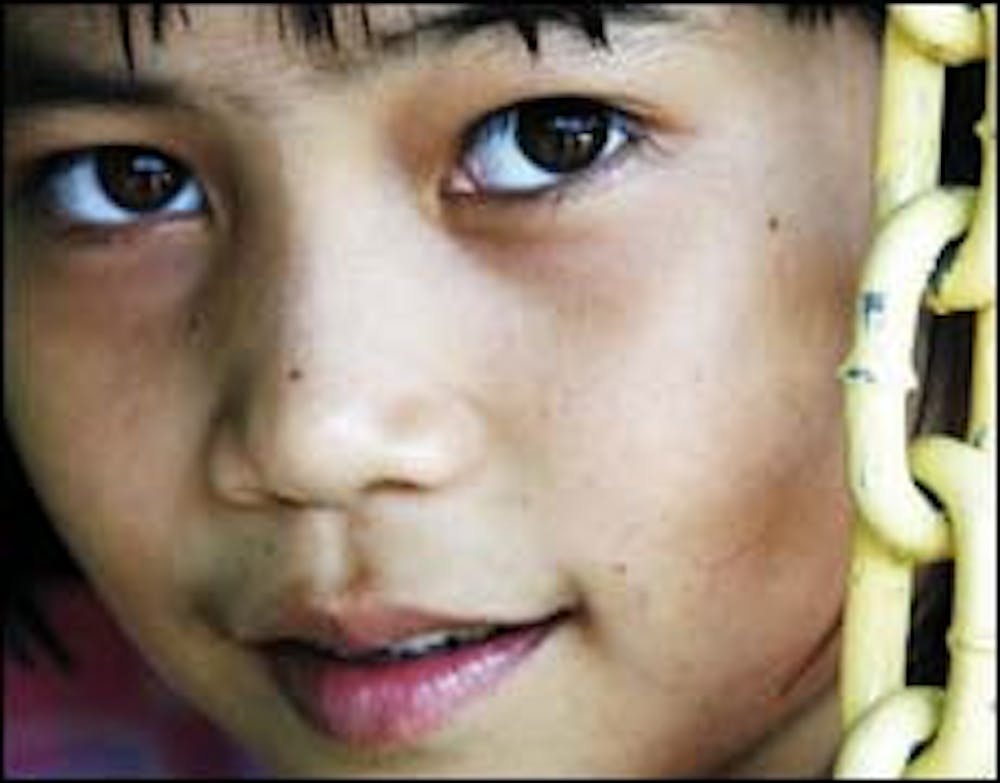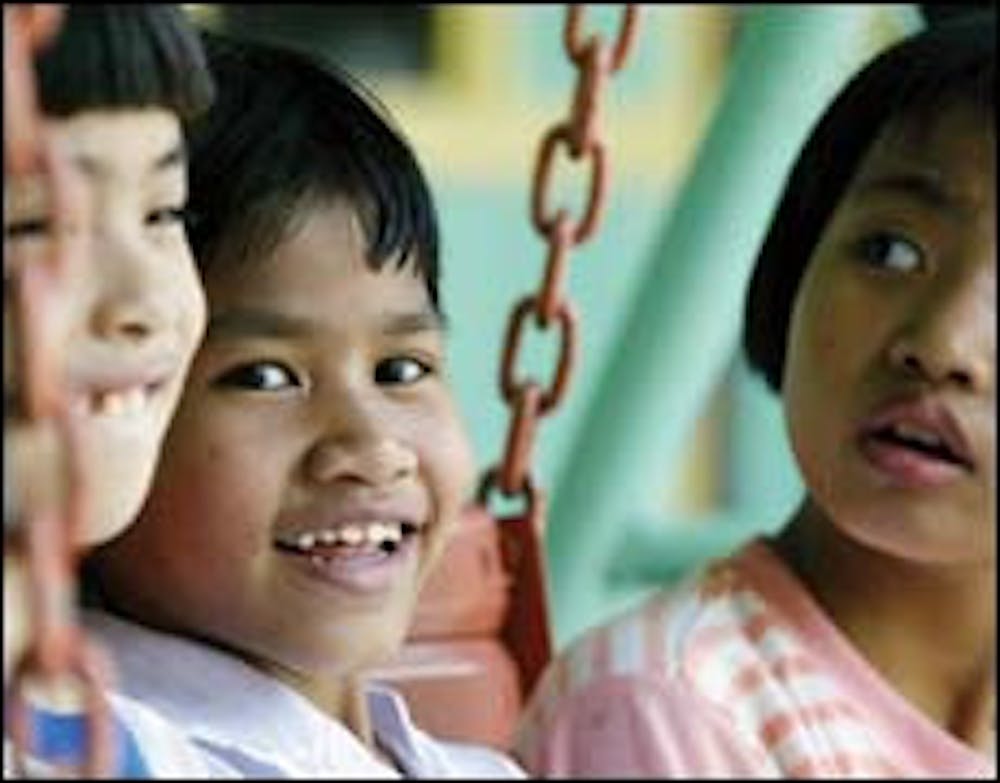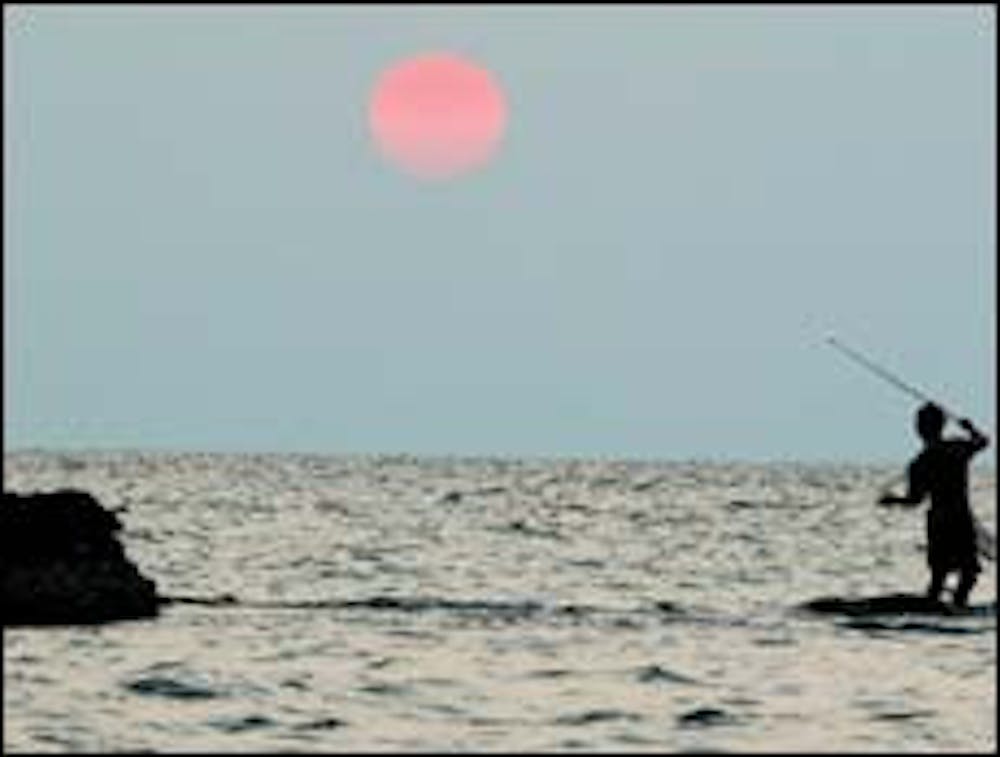In a place where white teeth signify savagery and close to 30 percent of its population lives in poverty, Vietnam has a new story to tell. Documentary photographer David Stone, an ASU alumnus, spent three weeks overseas gathering breathtaking images to help with this task.
Vietnam boasts thousands of tourists each year that want to view the untouched landscape. But the land is not all beauty. Scattered with a tumultuous past, the permanent effects of the Vietnam War are still evident -- men and women with missing limbs and broken buildings and families that have never been repaired. The look of disparity can be seen in the eyes of those who lived through it.
In April, Stone visited the Orphanage of Hue in Vietnam. There, he documented his moments with the children and the Buddhist monks that shelter and care for these abandoned lives.
By taking on this job he would get to do two things he loves most: travel and learn. Stone also liked the idea of helping out children in dire need of a voice of their own. Recording these images would give the orphanage a way to communicate to the rest of the world, telling stories of how they live and what their lives are about. The orphanage currently survives on funding from the Buddhist Church of Vietnam and donations from sponsors.
Through awareness, he hopes that others will contribute to the orphanage.
Forgotten voices
Stone arrived in Vietnam ready to work on April 3. His mission was to record the lives of the people there, all through the use of his camera. He knew the task wouldn't be easy, physically or emotionally. Not knowing what to expect, he had equipment ready and waiting for whatever lay ahead.
Stone traveled by boat through forests and swamps, to seek out a hidden location in Southern Hue that houses Buddhist temples and Emperors' tombs.
Then a driver took him to a remote location about 30 minutes away. Amidst the jungle, he peered through bamboo shoots and heavy vegetation. He saw a free-standing, earth-colored structure.
The Orphanage of Hue is housed in a hot and humid rain forest with no air conditioning. Windows and doors don't exist there. The complex is made from stone, plaster and wood. Haphazard pillars hold up this structure. There are separate sleeping areas, bathrooms and a kitchen. The classroom has no blackboard and the children's clothing is hand-washed and hung to dry in the sun. The orphanage residents have eaten the same items since move-in day: Beef, chicken, noodles, lettuce and rice. Fresh fruit is served for dessert.
Stone walked past the wooden bunk beds, none of which had mattresses. The children sleep with only thin, worn blankets. They wear standard-issue uniforms: white shirts and navy trousers or skirts. The children followed him around, and even though he does not speak their language, he knew they were asking him to take their picture.
"A lot of the boys followed me the minute I got there," Stone said. "I had my camera in hand and I obviously looked like an American, or a foreigner of some sorts and when I spoke -- 'America No.1!' -- I kept getting that from a lot of kids."
Yet most of the conversations he had were nonverbal. The orphanage director was a female Buddhist monk who spoke no English.
The safe haven is kept alive through joint funding from including Loan Vu, is an orphanage sponsor whom Stone accompanied on the journey.
She is from the area and considers giving back to her people and home community is important. Vu told Stone the orphanage usually houses in between 75 and 100 kids at a time, ranging in age from infants to 18-year-olds. Some had been there as long as six years.
There were some kids who were troublemakers in the eyes of Vietnamese law, but were too young to go to jail. Others had families who could not afford to care for them. And others were simply abandoned on the streets and were brought to the orphanage for food, shelter and a chance to survive.
There were several interesting things Stone noticed when he entered the orphanage. First, he saw the mixture of emotions in the children.
"Even though some kids were excited to see us, there were still kids that looked ill, worn out and sad," Stone said.
The next observation he made was how the children treated each other. Stone said the children didn't treat the mentally challenged ones any differently. They played and worked together peacefully, without taking notice of their differences.
Aside from his time at the orphanage, Stone presses on to other parts of the land. Other destinations on his list include Ha Noi (the capital), Hoi An, Nha Trang, Da Lat, Ho Chi Minh (Saigon) and a secluded island named Phu Quoc.
As a photographer, he experienced many events while there. He saw everything from deserted, moonlit beaches to colorful cities. Stone also looked on at rolling farms and country sides.
He even saw tragedy.
Crosswalks and roads are underdeveloped and the streets of Vietnam are unsafe, even for lifelong residents. Stone recalls witnessing a terrible motorcycle accident involving a young boy and an elderly man.
"I saw a 15-year-old boy die...he was twisted up a bit. Bloody," Stone said in almost a whisper. When asked what this particular experience was like for him, he replies after a long pause.
"Sobering. Really, it's a reality check," Stone said. "I mean, this guy was just kind of cruising on his motorcycle, enjoying a really beautiful night cause the sunset was really cool that night. I had just got done with a shoot at a fishing village with these local boats...it was just kind of a neat time. It was really pretty out...life's a fragile thing and people tend to forget that. Especially here in America."
Yet if you ask him, Stone will not say that he regrets what he has seen. He cherishes the images that he has had the change to record -- both on film and in his mind.
Behind the lens
A framed image of Wrigley Field will clue you in to Stone's love of baseball and his hometown team, the Chicago Cubs.
"I've been going to games since I was in my mom's womb, man!" Stone exclaims.
Sadly, his original dream of playing baseball ended after he had arm surgery after playing baseball at his prior college. He then decided to come back to Phoenix and attend ASU.
No matter how badly he missed playing ball, he always had his love for photography. Writing poetry for years, he liked relaying how he saw things. The visual aspect of photography is his way to represent things. Documentary-style photography allows Stone to bring stories to life through pictures. So the ex-college baseball player packed up his things after graduating from ASU and moved to Missoula, Mont. to attend photography school. He now spends his life documenting moments that are at times tragic and horrific, yet strikingly beautiful.
His favorite pictures are the ones that aren't posed.
"I hate traditional portraits," Stone said. "I like to capture you when you're not around. I blend in and people don't notice me around. That's a true photograph. Someone in their actual thought process as opposed to posing."
An only child, he was raised by his mother and stepfather. Growing up, he was given three simple guidelines from his parents: Don't lie, don't cheat and don't steal. These are the guidelines he still lives by today.
Stone is an upfront, no-holds-barred kind of guy who likes old-school punk, blues and a little bit of country.
If he's wearing a long-sleeved shirt, you can't tell that he has several tattoos. On his arms, Stone has a flaming heart with sun rays that surround a tattoo with the letters "PHX," a Latin saying meaning "to be rather than to appear" and an unfinished tattoo of an angel beating a demon with Asian wind bars all around. The tattoos represent his love for Phoenix, a saying he learned from his stepfather and the inner struggle of good and evil within himself, respectively.
"The warrior spirit is totally dwindling away. People aren't as passionate about things anymore," he responds.
And if you're worried if Stone is concerned with being judged for his tattoos, don't be.
"If you're going to judge me on my appearance then that's your thing. Life goes on," he says with a gentle smile.
Stone still writes a lot of poetry and goes to the gym a lot. His studies have taken him to London, Dublin, and the French Alps. He loves Mexican food, but his signature dish is his chicken pistachio.
Curious by nature, his wondering mind has led him to new subjects for his craft.
Stone met a stranger in a bar three years ago in Missoula while in photography school. He quickly learned that his new friend happened to be formerly employed at a local butcher shop. Stone, intrigued by this profession, convinced the man to take him behind the shop's usually closed doors.
There, he found death, gore and a new appreciation for the food on his table.
Somber house
When Stone first arrived at the butcher shop, he immediately noticed something that the employees all have in common. They are all male, strapped with weapons and staring him down.
"They were pretty nuts," Stone said. "Middle-aged to early 50s or 60s. They're all lean and muscular. They all had aprons on and they all have these metal knife holders. You should see the way they work with knives."
Stone snapped his fingers.
"They're quick," he said.
Although Stone said he was unable to reveal the name of the butcher company, he relived what he saw.
In a cold building, he witnessed a bull waiting in the "Gut it and cut it" station. The bull was being prodded in the testicles just before it got shot with a 22-inch rifle. After the bull was shot, it was quickly stabbed in the back of the head. Its throat was slit.
"It's like someone turned on the faucet, but it's all blood," Stone added with a disturbed look.
Finally, the bull was chained from its Achilles heel and its skin was removed. Stone witnessed three bulls and three pigs go through the same process that day.
"There was one guy who was talking trash to the bull, swearing at it," Stone said. "But overall, they were really nice guys."
Not used to the dark humor of the employees, Stone still understood why the needed to make light of the situation.
"They're around death all the time," Stone said. "You look in their eyes and nothing bothers them."
When Stone was finished with the shoot, he didn't have an original purpose for the images, he said. But he soon discovered that others would have the chance to admire his work.
"I didn't actually know what they would evolve into," he said, laughing. "Two of the pieces were shown at the Saintonage gallery in Missoula."
Not only was his show a success, Stone also has a newfound respect for these men.
"I had no idea how much work was involved. It's also dangerous. You're working with guns in a cement building...I had a new respect for where my meat comes from," he said.
Paradoxical brilliance
Looking back on his travels, Stone remembered that it
wasn't easy touching his native soil after so long.
"I had culture shock coming back home," he admits.
A memory that Stone holds dearly involves a perfectly preserved shell from the beaches of Phantiet. The shell is swimming in sand from the White Sand Dunes in an intriguing wooden box deocrated with hand-carved frogs. The inscription reads: "4-18-05, 12:45 a.m."
"I was by myself and the water has gone back a lot so there is a lot more beach. It's extremely dark except for all the lights outlining the land. So there's nothing but these lights from the resorts along this beautiful beach at night, these hundred of fishing boat lights way out in the distance, the ocean, the black sky, and above that, millions of stars and you can see 'em all...and then there's me. There's nobody on the beach...I'm by myself and I found this shell. It was really a spiritual time for me...a time to self-reflect."
His last words on Vietnam are on the country's paradoxical brilliance.
"It's a dangerous country; it's beautiful. And absolutely gorgeous."
The two important lessons he's learned from his experiences of both the orphanage and of the butcher shop sound simple but are often forgotten: Appreciate life and stop to smell the flowers.
Reach the reporter at kalea.yoshida@asu.edu.








